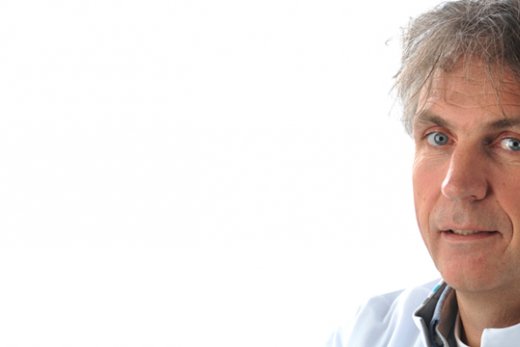07/01/2018
Personal stories: Stijn Konings
A biosensor for vancomycin would be really helpful
We spoke with Stijn Konings, an internist-nephrologist from the Catharina Hospital in Eindhoven, about the benefits that biosensors can bring in healthcare and how a biosensor for antibiotics can help patients.
My name is Stijn Konings, I have been working as an internist-nephrologist at the Catharina Hospital in Eindhoven since 2002. Most of the time I work at the dialysis department, together in a broad team, to provide the best care for the patient. I am especially concerned with cardiovascular diseases in patients with renal insufficiencies. Furthermore I focus on the self management and home treatment of patients having renal function replacement therapy.
Sometimes I find it difficult to see people having a disease, especially young kidney patients, because it is hardly possible to completely cure these patients for the rest of their lives. Additional therapies will always be needed. At the same time, one of the pros of this work is that there is a good treatment available for these diseases, like replacement of the whole organ or replacement therapies. This brings a positive perspective for the patients. We try to involve the patients as much as possible in their treatment, and we also stimulate treatment at home. When patients have more control, they feel less sick. They are more stimulated to stay positive and can function in the society. It is always a nice challenge to work as a team in order to come up with the best treatment for the patient. But of course, preferably we want to prevent kidney diseases in the first place.
Antibiotic resistance
I think that antibiotic resistance is a massive problem. Antibiotics are excessively used and in the wrong way, especially in the south of Europe. This wrong use can cause resistance against the antibiotic, causing massive problems for society. In my opinion, doctors and microbiologists should consider whether to give a patient antibiotics or not. This should also be done on worldwide level to prevent the spread of antibiotic resistant bacteria from other countries.
In practice, the treatment of patients can be negatively influenced by resistant bacteria. When patients return form their holiday, they are investigated thoroughly for antibiotic resistant bacteria before hospitalization. This is done to prevent possible spreading of antibiotic resistant bacteria that the patients might be carrying. Because when they carry such bacterium they have to be treated in an isolated room. This not only costs a lot of money, but also brings a lot of waste, like the use of extra prevention tools, which all is very inefficient.
Vancomycin
As nephrologists, we work a lot with vancomycin. We mainly prescribe it when patients show resistance for certain antibiotics. It is also used in patients that undergo peritoneal dialysis, because it can easily be administered with the peritoneal liquid. Since vancomycin has a small therapeutic window, the administered dose should be precisely controlled to prevent resistance and toxicity, and thereby more damage to the kidneys. When we treat patients intravenously with vancomycin, we measure trough levels, i.e. the lowest concentration reached before the next dose is administered. This is done after dialysis to prevent washing of vancomycin. Based on the results, the patient will be dosed again with the right dose of vancomycin to reach the right level in the blood.
A biosensor would be really helpful. We would no longer have to measure trough levels, which takes a lot of time and has a certain delay. Nowadays it takes 12-24 hours to receive the results from the lab and we are not able to rapidly adapt the medication. When we are able to directly measure the vancomycin concentration after dialysis with a biosensor, we can directly give the next dose to prevent any resistance or possible toxicities.
Biosensors
In general, the use of biosensors would be very beneficial in healthcare. Not only could we measure very fast, but it is also more patient friendly. It can really be an enabler for treatment at home. Nowadays blood has to be taken from the patients at home and the samples are sent to the lab. This gives transportation costs and the lab is not always available to directly analyse the blood. It would be wonderful to measure all of this with a biosensor. Of course, the development of a biosensor would require an investment, but I think this will be earned back over time. Furthermore, a biosensor would make treatment so much more personal. The patient or the caregiver would be able to adapt the medication at any time. This all provides a better quality of life.
Biosensors of the future
I think that biosensors will especially be helpful for patients with a chronic disease. We would for example like to measure hydration levels and urine markers. Also a biosensor to measure the antibiotic gentamicin would be important. Gentamicin is nephrotoxic, so needs to be carefully dosed in order to avoid kidney damage.
People often think that the hospital is the ‘holy place’. What they do not realize is that the hospital is a place where many people come together and therefore also a lot of bacteria circulate, including bacteria that could be resistant. Treatment at home would be safer because of a lower chance of getting infected by bacteria. Biosensors could enable treatment at home. In short, home therapy is the future!
SensUs Competition
Young researchers working on societal problems will lead to novel ideas. These might seem weird at first sight, but we need new startups to work on those new ideas. I think we should really stimulate young people and give innovation a chance. They are the new generation and the clever ones of the future. SensUs is a good example of stimulating young students to develop new ideas. Keep it up!


Facebook
YouTube
LinkedIn
Instagram